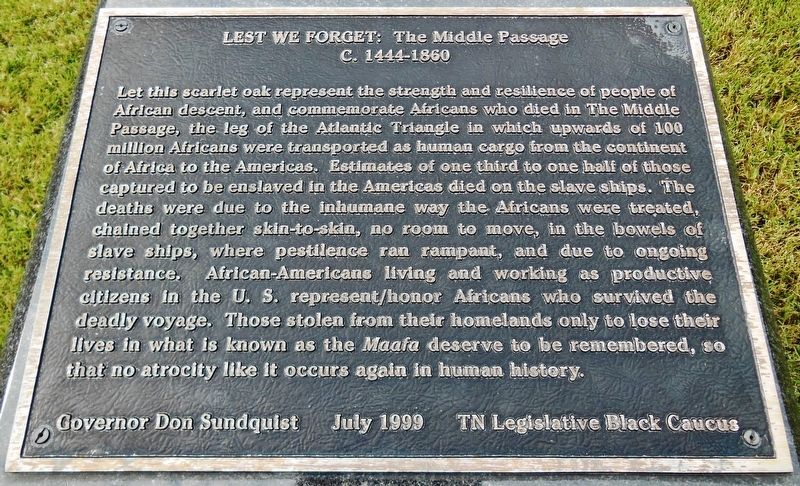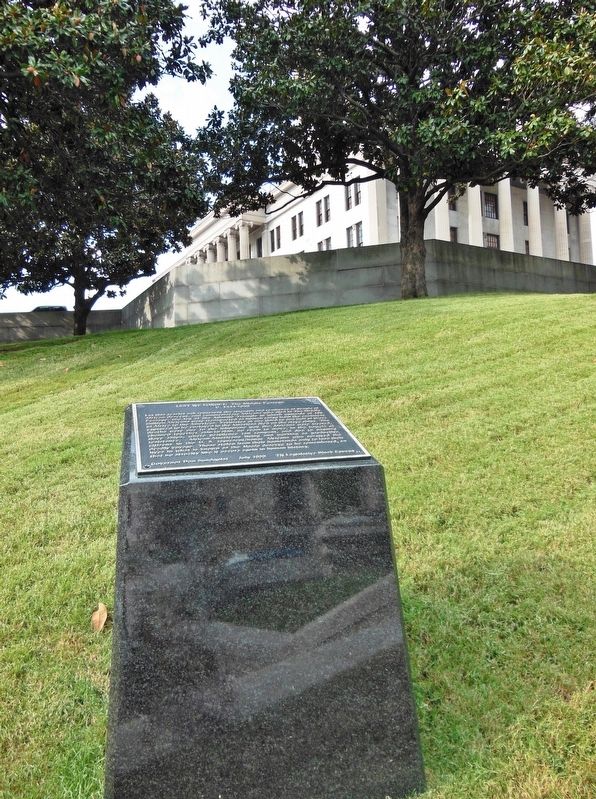North Capitol in Nashville in Davidson County, Tennessee — The American South (East South Central)
Lest We Forget: The Middle Passage
C. 1444-1860
Let this scarlet oak represent the strength and resilience of the people of African descent, and commemorate Africans who died in the Middle Passage, the leg of the Atlantic Triangle in which upwards of 100 million Africans were transported as human cargo from the continent of Africa to the Americas. Estimates of one third to one half of those captured to be enslaved in the Americas died on the slave ships. The deaths were due to the inhumane way the Africans were treated, chained together skin-to-skin, no room to move, in the bowels of slave ships, where pestilence ran rampant, and due to ongoing resistance. African-Americans living and working as productive citizens in the U.S. represent/honor Africans who survived the deadly voyage. Those stolen from their homelands only to lose their lives in what is known as the Maafa deserve to be remembered, so that no atrocity like it occurs again in human history.
Erected 1999 by TN Legislative Black Caucus and Governor Don Sundquist.
Topics. This historical marker is listed in these topic lists: African Americans • Colonial Era.
Location. 36° 9.903′ N, 86° 47.061′ W. Marker is in Nashville, Tennessee, in Davidson County. It is in North Capitol. Marker is on Dr. Martin Luther King, Jr. Boulevard east of 7th Avenue North, on the right when traveling west. Marker and monument are located near the southwest corner of the Tennessee State Capitol grounds. Touch for map. Marker is at or near this postal address: 600 Charlotte Avenue, Nashville TN 37219, United States of America. Touch for directions.
Other nearby markers. At least 8 other markers are within walking distance of this marker. Mrs. John Hill Eakin - Mrs. Robert F. Weakley (within shouting distance of this marker); Tennessee State Capitol (within shouting distance of this marker); Motlow Tunnel (within shouting distance of this marker); a different marker also named Tennessee State Capitol (within shouting distance of this marker); Samuel Dold Morgan 1798-1880 (within shouting distance of this marker); Tennessee Tower (within shouting distance of this marker); Operation Desert Shield and Desert Storm (about 300 feet away, measured in a direct line); Operation Enduring Freedom (about 300 feet away). Touch for a list and map of all markers in Nashville.
Regarding Lest We Forget: The Middle Passage.
From The Colonial Williamsburg Foundation:
"The enslaved Africans were from different countries and different ethnic and cultural groups. They spoke different languages. Many had never seen the sea before, let alone been on a ship. They
had no knowledge of where they were going or what awaited them. The voyage usually took six to eight weeks. There are a very few accounts of the Middle Passage written by enslaved Africans who had experienced conditions on a slave ship firsthand. One well known African writer who did experience the crossing was Olaudah Equiano. He wrote, “The shrieks of the women and the groans of the dying, rendered the whole a scene of horror almost inconceivable”, in his autobiography The Interesting Narrative, published in 1789."
The marker uses the year 1444 as the beginning of the Maafa, as that year marked when the Portuguese brought enslaved people from Africa to work on the sugar plantations of the Madeira Islands, off the coast of modern Morocco.
Also see . . . Black African Holocaust. Maafa homepage:
Maafa is a Kiswahili term for disaster, calamity or terrible occurrence. This term has been used to describe the Trans-Atlantic Slave Trade/Middle Passage. people of African Descent are invited in an attempt to honor our ancestors who have suffered through the middle passage AND the lives that continue to be compromised due to racism and oppression. (Submitted on March 19, 2019, by Cosmos Mariner of Cape Canaveral, Florida.)
Credits. This page was last revised on February 7, 2023. It was originally submitted on March 19, 2019, by Cosmos Mariner of Cape Canaveral, Florida. This page has been viewed 351 times since then and 38 times this year. Photos: 1, 2. submitted on March 19, 2019, by Cosmos Mariner of Cape Canaveral, Florida.

